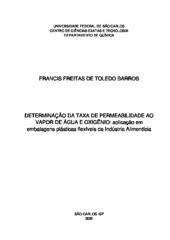| dc.contributor.author | Barros, Francis Freitas de Toledo | |
| dc.date.accessioned | 2022-10-20T12:03:15Z | |
| dc.date.available | 2022-10-20T12:03:15Z | |
| dc.date.issued | 2022-09-22 | |
| dc.identifier.citation | BARROS, Francis Freitas de Toledo. Determinação da taxa de permeabilidade ao vapor de água e óxigênio: aplicação em embalagens plásticas flexíveis da indústria alimentícia. 2022. Trabalho de Conclusão de Curso (Graduação em Química) – Universidade Federal de São Carlos, São Carlos, 2022. Disponível em: https://repositorio.ufscar.br/handle/ufscar/16906. | * |
| dc.identifier.uri | https://repositorio.ufscar.br/handle/ufscar/16906 | |
| dc.description.abstract | Package has multiple functions, including protecting a product. This protection is mainly associated with two aspects. The first is the protection against physical and mechanical damage during transport and storage. The second, dealing specifically with food, is the protection against environmental factors, such as gases, water vapor, light and odors. Thus, a package must have an adequate barrier that prevents or hinder a contact between the external environment and the product inside. Therefore, specific analyzes are necessary to verify this barrier that the package can provide, that is, how permeable or not it is to these factors, such as the permeability rate to water vapor and oxygen. Since when it comes to the food industry, attention should be paid to these factors, because the oxygen in contact with food allows the growth of spoilage aerobic microorganisms, and the increase in humidity, in foods with low water activity, favors the growth of microbial growth, fat oxidation, loss of crunchiness, among others. In this sense, the present work focused to evaluate, in the form of a bibliographic review, the analyzes to determine the permeability rate to water vapor and oxygen applied to flexible plastic package used in the food industry. | eng |
| dc.description.sponsorship | Não recebi financiamento | por |
| dc.language.iso | por | por |
| dc.publisher | Universidade Federal de São Carlos | por |
| dc.rights | Attribution-NonCommercial-NoDerivs 3.0 Brazil | * |
| dc.rights.uri | http://creativecommons.org/licenses/by-nc-nd/3.0/br/ | * |
| dc.subject | Embalagem | por |
| dc.subject | Permeabilidade ao vapor de água | por |
| dc.subject | Permeabilidade ao oxigênio | por |
| dc.subject | Package | eng |
| dc.subject | Oxygen permeability | eng |
| dc.subject | Water steam permeability | eng |
| dc.title | Determinação da taxa de permeabilidade ao vapor de água e óxigênio: aplicação em embalagens plásticas flexíveis da indústria alimentícia | por |
| dc.title.alternative | Determination of the rate of permeability to water steam and oxygen: application in flexible plastic packaging for the food industry | eng |
| dc.type | TCC | por |
| dc.contributor.advisor1 | Carneiro, Renato Lajarim | |
| dc.contributor.advisor1Lattes | http://lattes.cnpq.br/8065852319463976 | por |
| dc.description.resumo | Embalagens têm inúmeras funções, dentre elas a de proteger um produto. Sendo essa proteção associada majoritariamente a dois aspectos. O primeiro se trata da proteção contra danos físicos e mecânicos durante transporte e armazenagem. O segundo, se tratando especificamente de alimentos, com a proteção contra fatores ambientais, tais como gases, vapor de água, luz e odores. Dessa forma, uma embalagem deve ter uma barreira adequada que impeça ou dificulte o contato entre o ambiente externo e o produto em seu interior. Assim, se fazem análises específicas que verifiquem essa barreira que a embalagem consegue prover, ou seja, o quanto ela é permeável ou não a esses fatores, como a taxa de permeabilidade ao vapor de água e oxigênio. Em se tratando de embalagens da indústria alimentícia, deve-se atentar a esses fatores, pois o oxigênio em contato com alimentos permite o crescimento de microrganismos aeróbios deteriorantes, e o aumento de umidade, em alimentos de baixa atividade de água, favorece o crescimento microbiano, a oxidação de gorduras, perda de crocância, entre outros. Nesse sentido, o presente trabalho teve por objetivo avaliar, na forma de revisão bibliográfica, as medidas para determinação da taxa de permeabilidade ao vapor de água e ao oxigênio aplicadas em embalagens plásticas flexíveis da indústria alimentícia. | por |
| dc.publisher.initials | UFSCar | por |
| dc.subject.cnpq | CIENCIAS EXATAS E DA TERRA::QUIMICA::QUIMICA ANALITICA | por |
| dc.publisher.address | Câmpus São Carlos | por |
| dc.contributor.authorlattes | http://lattes.cnpq.br/0222715705654945 | por |
| dc.publisher.course | Química - Q | por |

